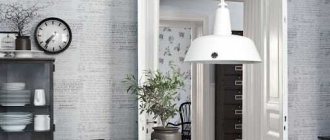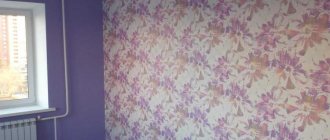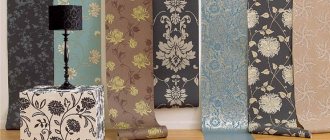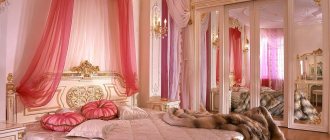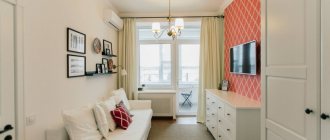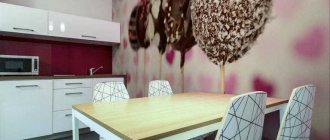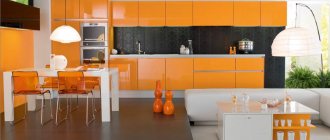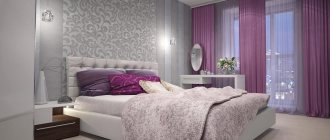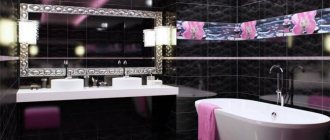Recently, a new type of finishing materials has appeared on the construction market - liquid wallpaper. This is a finishing coating for ceilings and walls, combining the properties of decorative plaster and ordinary roll wallpaper. The practicality and durability of this type of finish have made it very popular in the repair industry. Liquid wallpaper has universal application. They can be used in different rooms, including the kitchen, where the temperature and humidity levels are constantly changing.
This amazing coating can look like wallpaper, look like decorative plaster or imitate stone
What is liquid wallpaper?
In its original form, liquid wallpaper is a dry mixture packaged in bags. Before use, the material is diluted with water, and then the resulting thick and viscous mass is applied to the working surface.
Liquid wallpaper is sold in the form of dry flakes, packaged in bags depending on color
Before use, liquid wallpaper is diluted with water at room temperature.
The finished composition is applied to the wall or ceiling like plaster.
The composition of liquid wallpaper includes:
- cellulose or silk fibers;
- binder (paste, bustylate, wallpaper glue, PVA);
- antiseptics that ensure the finish is resistant to mold and mildew;
- acrylic or latex paints that give the coating any color;
- decorative components (pearl sparkles, marble chips, colored threads, etc.).
Components of liquid wallpaper
Liquid wallpaper can be smooth or textured. In the first case, the coating looks like a flat surface, and in the second, it resembles a soft canvas. However, both types of finishes do not create seams when applied. In addition, they help hide various defects of the working surface (irregularities, depressions, small cracks).
Liquid wallpaper can be used to cover the entire wall or any area.
The technique of applying liquid wallpaper allows you to create various shapes from it
A border is the simplest element that can be made from liquid wallpaper
Using this finishing material, you can create exclusive designs by combining multi-colored mixtures in accordance with fashion trends and your own preferences.
Using liquid wallpaper you can create a truly stylish and memorable room design
How to care
According to reviews, liquid wallpaper does not require particularly complex care. It is important to remember that wet cleaning is strictly contraindicated for them. Contact with moisture may cause the coating to deteriorate.
Caring for liquid wallpaper must be done according to the rules.
We recommend using dry cleaning. Vacuum cleaners with soft brushes have proven themselves well. It is enough to carefully clean the wallpaper once a week to maintain its appearance.
Instead of a rag, it is better to use a vacuum cleaner or brush.
Sometimes online there are recommendations to coat liquid wallpaper with varnish. We strongly advise against doing this: the mixture may behave unpredictably. Firstly, you are almost guaranteed to lose the characteristic relief for which liquid wallpaper is valued. Secondly, the color can change in the most unexpected ways. Therefore, dry cleaning will be sufficient.
It is not varnish that will help preserve wallpaper, but proper care.
It’s more difficult if stains appear on the wallpaper. If there are drops of food or grease, carefully remove them with a soft cloth. If there are traces left, you will have to wash them off with water, and then correct the bald spot with the diluted mixture, applying a patch.
A patch on liquid wallpaper will return it to its original appearance.
Remove yellow stains with a bleach solution (1:3) and putty with the mixture.
Removing yellow spots is difficult, but possible.
Is it possible to use liquid wallpaper in the kitchen?
The walls and ceiling in the kitchen have to be washed frequently, since not only dust, but also grease deposits and soot settle on them. However, liquid wallpaper is not moisture resistant. When exposed to water, they are immediately washed off from the work surface. They can only be cleaned with a dry cloth or special attachments for a vacuum cleaner. Of course, these methods will not help cope with severe pollution. But this does not mean that it is completely impossible to use this finish in the kitchen. Liquid wallpaper in the kitchen can be used around the entire perimeter, except for the cooking area.
It is better to use tile finishing on the kitchen apron
If the finish is coated with acrylic varnish, it will become waterproof. At the same time, the coating will change slightly in color and its texture will become rougher.
An accent wall in the kitchen dining area is the best place for liquid wallpaper
Overall, this material is very convenient for the kitchen. It does not interfere with the access of oxygen to the working surface, which allows you to maintain an optimal level of humidity in the room. After drying, the wallpaper is not afraid of drafts and prolonged exposure to high temperatures, and also does not absorb various odors.
Can it be used?
Liquid wallpaper is a bulk material that is diluted with water or a special compound and applied to the wall. They dry quickly, do not emit unpleasant odors, and look aesthetically pleasing. In addition, this coating is completely non-toxic. Even when heated, it does not release toxic mixtures. Liquid wallpaper is not fire hazardous and tolerates temperature changes well. However, all this is true only if we talk about original products from quality brands.
High-quality liquid wallpaper allows you to create a reliable and stylish coating.
What liquid wallpaper can be used in the kitchen? First of all, let's give some general recommendations :
- Buy materials only from trusted stores that value their reputation. Improper storage can affect the properties of liquid wallpaper: it will be poorly applied, form clumps, crack and fall off.
- You should not purchase products from unknown brands. To reduce the cost of production, they may use low quality ingredients.
- Does the mixture smell strange or look uneven? A reason to refuse a purchase.
- Liquid wallpaper from a well-known company cannot be cheap. If you are offered suspiciously cheap packages of formula, most likely it is a counterfeit or substandard product.
What liquid wallpaper should I buy for the kitchen? From the general range there are several manufacturers that have proven themselves:
Budget option - Silk Plaster . The Russian brand is relatively inexpensive - approximately 195 rubles per packet of the mixture. However, they also have a premium option - 1,760 rubles per package of the mixture. One package is enough to paint an area of 3.5 square meters.
The Russian manufacturer offers a wide palette.
Turkish products Bayramyx . Their quality is at the level of their Russian competitor, but the choice of colors and textures is much wider. The price starts from 1990 rubles per package of the mixture, which is enough for 4 square meters.
Bayramix has a soft, suede texture.
If you want a truly luxurious renovation, then think about the French company RMD , which produces various types of liquid wallpaper that imitate not only plaster, but also stone and even wood. One kilogram package of the mixture costs from 3 thousand rubles.
French wallpaper looks really luxurious.
We recommend that you turn to trusted brands and not take risks by buying an unknown mixture: it is likely that it will turn out to be not only of poor quality, but also hazardous to health.
High-quality liquid wallpaper is expensive, but you get the corresponding result - a safe and reliable coating that will serve you for many years.
Good wallpaper will allow you to create real design masterpieces.
Advantages and disadvantages of using liquid wallpaper in the kitchen
Using this type of finish in kitchen interior design has many advantages:
- The structure of the mixture does not contain harmful substances, so it is completely safe for health and does not cause allergic reactions.
- The material is elastic, which means it can be used to create various arches, ledges and niches.
- Wallpaper does not crack due to natural shrinkage of the walls.
- If the coating is damaged, it is enough to wet the damaged part, remove it from the wall and apply a new mixture to this place.
Restoring a damaged fragment of liquid wallpaper takes literally 5 minutes - The material has good thermal insulation. Consequently, heat loss in the room will be minimal even in the autumn-winter season.
- The texture of the wallpaper is quite dense, which provides it with good soundproofing properties.
Liquid wallpaper easily hides minor wall imperfections
However, this finishing material also has disadvantages:
- High price.
- Instability to direct sunlight.
- The mixture takes a long time to dry after application to the work surface (up to 10 hours).
Liquid wallpaper is used not only for wall decoration, but also for decorating the ceiling
Preparation of the composition
Liquid wallpaper is sold in stores in dry form. Water is poured into the mixture in advance and everything is thoroughly mixed. The exact proportions are always indicated by the manufacturer in the instructions.
The finished mass is most often poured back into a thick plastic bag and allowed to brew for 8-10 hours for full swelling.
Attention! You must understand that the dried coating will be much lighter than the wet one. This feature should be taken into account when adding coloring pigments to the solution.
What liquid wallpaper is suitable for the kitchen?
When choosing liquid wallpaper for the kitchen, you should pay attention not only to its visual appeal, but also to practicality. In this case, the decorative finish will be used for at least 10 years, maintaining its original attractiveness throughout its entire service life.
High-quality liquid wallpaper is a fairly durable finishing material
It is better to purchase coatings of non-uniform colors that contain a large number of decorative elements, since on such wallpaper minor dirt (stains, drops of grease, etc.) will not be very noticeable.
The material is expensive, but you can’t skimp on it. German and French companies are considered the best manufacturers, and products from unknown companies should be discarded.
An interesting solution would be to combine liquid wallpaper with other finishing materials (wood, wall panels, tiles, slate stone, gypsum brick, etc.).
You can create a beautiful pattern on the wall from liquid wallpaper using stencils
Application technique
Prepare tools and materials:
- putty, primer, water-based paint to match, acrylic varnish;
- trowel;
- spatulas of different sizes;
- paint and structural rollers;
- container for dilution.
The mixture is prepared before work begins. Knead the bag of powder, breaking up the lumps. Pour it into a container with warm water, at the same stage add decorative additives.
- Mix all components by hand until a homogeneous mass is obtained.
- Leave the liquid wallpaper to swell for the time recommended by the manufacturer.
- After the end of the exposure time, the material is kneaded again and water is added if necessary.
Preparing the walls
After applying and drying the liquid wallpaper in the living room, all defects in the base will become visible: dark spots, cracks will become visible. Therefore, the preparation of the walls should be carried out carefully.
- Remove old coatings: soak the wallpaper and remove it, wash off the whitewash with a soap solution, and remove the oil paint with a spatula or a special solution.
- All elements protruding above the surface are dismantled, and non-removable metal ones are treated with anti-corrosion impregnation.
- Traces of mold and rust are thoroughly cleaned and treated with neutralizing compounds;
- Cracks and drywall joints are filled with putty;
- The surface is primed and covered with two layers of water-based paint.
This is done so that putty spots do not show through the decorative composition.
Application
After the paint has dried, begin applying liquid wallpaper to the wall.
Work is carried out from top to bottom and from the corner to the center.
The prepared mixture is thrown onto the trowel with a spatula. The working tool is held at an angle of 5-15° to the surface. Using a rubbing motion in one direction, the material is applied to the base with a layer thickness of 2-3 mm.
Each subsequent stroke should slightly overlap the previous one: this creates a seamless connection.
You can diversify the relief by applying the mixture in a circular motion. If the consistency is thick, wet the smoothing iron.
An hour after completion of work, the surface is inspected and defects are eliminated.
Types of liquid wallpaper
This finish is divided into 3 groups, differing from each other in composition and performance properties.
Cellulose wallpaper
The main component of this material is wood fibers. It differs from its analogues in its affordable price, retains heat well in rooms, and masks minor defects on the walls and ceiling. However, this finish quickly fades in the sun, so it is recommended to use it not in the kitchen, but in other areas of the apartment protected from ultraviolet radiation (for example, in the hallway).
The durability of cellulose wallpaper is at the initial level, but anyone can afford such material, because its price is an order of magnitude lower
Silk wallpaper
The covering is made from threads of artificial or natural silk, as a result of which it has a pronounced satin shine and velvety feel. The material is much more expensive than other types of finishes, but the high price is due to its excellent performance characteristics. Wallpaper is durable, has increased strength and does not change color under the influence of bright sunlight. Hence, they are ideal for use in kitchen areas.
Liquid wallpaper based on silk fibers is resistant to ultraviolet radiation
Silk-cellulose wallpaper
The mixture is made from crushed wood, but colored chopped silk fibers are added to it. Silk threads here perform only a decorative function, giving the wallpaper a characteristic shine and texture. It is cellulose that provides the performance characteristics, so the coating is suitable only for rooms with low operational load.
Silk-cellulose wallpaper - a reasonable compromise between price and quality
Flaws
It would seem like an ideal finishing option? But, like everywhere else, there are some nuances here.
- High price. This is not a budget material, unlike their “dry” counterparts; you won’t be able to buy a roll for 150 rubles.
- Good absorbency. And this is not an advantage - such a coating cannot be placed near wet places.
- Limited number of colors and textures. In fact, all options come down to a couple of textures and a small palette of colors, which in some interiors can be a serious disadvantage.
unsplash.com
- Decoration Materials
How to make liquid wallpaper with your own hands: choosing ingredients and a universal recipe
Features of choosing liquid wallpaper in accordance with kitchen design
Plain, smooth coverings are suitable for kitchens decorated in a classic style. For small rooms, the ideal option would be silk wallpaper in beige, light blue and peach tones.
An example of decorating a wall with liquid wallpaper, the color of which is in harmony with the decorative decoration of the ceiling in a classic kitchen
From materials of different colors you can create a unique original design on the wall
Gray models look good in styles such as loft and Provence. For a boho design, you need to choose bright coatings with a velvety texture.
Bright interior of the kitchen dining area in boho style with plain wall decoration with liquid wallpaper
This type of wall decoration would be appropriate in a kitchen in a minimalist style.
To zone the space in a spacious kitchen, you can use liquid wallpaper of different colors. The main thing is that all the shades used are harmoniously combined with each other.
An original composition of multi-colored liquid wallpaper, made by the hands of the owner of the house
Most liquid wallpaper in the kitchen, photos of which are presented on the Internet, are designed in light colors: gold, pink, green, white, but rich colors (purple, blue, orange) will also be a stylish solution for this room.
Kitchen in a modern style with light-colored liquid wallpaper
Liquid wallpaper is an excellent way to decorate the walls and ceiling in the kitchen. A wide range of shades and fillers of this material allows you to make the interior of the room completely unique. By combining dry mixtures with each other, you can create excellent compositions, and seams will not form on the work surfaces, worsening the appearance of the coating.
Choosing a color palette
The white mixture leaves a lot of room for imagination. They can be painted in any shade, and also complemented with any decorations. A palette of ready-made mixtures is also widely represented on the market. Cellulose ones have soft natural shades, since the composition contains wood: white, cream, yellow, beige, brown of different shades, chocolate.
Bright colors are popular for silk, as they are resistant to fading: red, purple, green, orange, blue, burgundy, turquoise.
Cotton ones have a palette of calm shades - natural and pastel natural colors.
Canvases with decorative particles look good in the kitchen interior, since plain liquid wallpaper makes dirt stand out more strongly. Blue, green, beige, pink shades are suitable for kitchens.
Liquid wallpaper in the kitchen – 50 photos
Advice from professionals
In order to obtain interesting compositions and textures, you can mix several shades at once. To make a relief pattern of waves and stripes, you need to increase the thickness of the layer and use a notched spatula. From liquid wallpaper you can create various wall designs, including imitating brickwork, facing stone or marble finishing.
